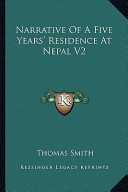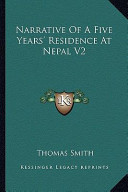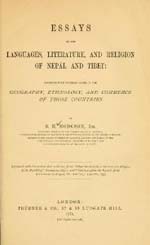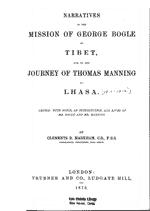
Thomas Smith, Narrative of a Five Year’s Residence at Nepal [London: Colburn and Co, 1852]
Thomas Smith’s Narrative of a Five Year’s Residence at Nepal [London: Colburn and Co, 1852] brings all the excitement of the story of Nepal in the first half of the nineteenth century. The book is divided into two volumes. The narrative is one of the best accounts of the intrusion of the British army into the pristine glory of Nepal. Written by a young officer, who was based in Kathmandu as assistant political resident from 1841 to 1845, the book is also based on his personal experience in Nepal.
In the preface of the book, the author flags the necessity of writing the book on two grounds. The “friendly character of the relations which exist between England and Nepaul” and the position “which Nepaul already holds in Anglo-Indian history” created this imperative. He emphasizes that the story of Nepal to be given in the book should look complete, and ” nothing should be omitted which can throw light on its characteristics and history.” The idea was to prepare a reference work on Nepal. Several other works have been written in reference to Nepaul; but the Author of the present one confidently believes that no complete account of the kingdom, and all that relates to it, has been published until now.
Captain Smith starts his narrative with personal adventure of an overland trip from England to India via France, Italy and Egypt. Following this exciting journey, he writes about the topography of Nepaul, the animals available in this country with some narratives of sport in the forest, the inhabitants of Nepaul, especially the military tribes, Nepaul’s manners, customs and laws, and a short history of the country.
In the background of these narratives, the author explains the passion of the Goorkhas for “territorial aggrandizement,” the “aggressive conduct” of their international border security officers, the tedious and unfriendly discussions carried on between them and the East India Company with reference to some disputed lands and the subsequent declaration of the Anglo-Nepalese War (1814–15) by the British side. There are stirring details of the war continued at different fronts in different chapters. There is detailed account of the termination of first campaign which resulted in Gurhwal being restored to its King, and the superintendence of the affairs of all the western chiefs being vested in General David Ochterlony. After two costly and unsuccessful attempts to seize the Nalapani fort by direct attack, the British changed their approach and sought to force the garrison to surrender by cutting off the fort’s external water supply. Nepal had started to lose. There was no full stop. This follows negotiation of peace between warring sides.
The post war Nepal remained nice to the British. Captain Smith appreciates that Nepaul did not furnish any fresh ground for quarrel in the next twenty-two years. “The treaties were respected, and the internal condition of the Kingdom was peaceable.” It is in this environment that the Nepaulese mission to England led by General Jung Bahadur, who had recently emerged as the new General in Kathmandu, was planned. He was able to show his power and clout as a visiting dignitary. The British people were impressed, but were not clear about the objective of the visit as such. Smith notes: “Nepal certainly had got herself into bad odour with the government of India by her unfriendly intrigues with the government of Lahore and Gwalior, during the period of [British] hostilities with these states.” He says: “The Nepaulese, however, situated as they are between two nations, both far too formidable to be resisted, may feel their position awkward and embarrassing; and the late mission may have originated in a desire to ascertain the power, resources, and the Indian policy of the most formidable of them.”
The book gives a special focus on General David Ochterlony, who led Britain to victory. On the outbreak of the war he was given the command of one of four converging columns, and subsequently he was promoted to the command of the main force in its advance on Kathmandu, and outmaneuvering the Gookhas by a flank march at the Kourea Ghat Pass, bringing the war to a successful conclusion and obtaining the signature of the Treaty of Sugauli (1816). The author, who was a Captain at the time of writing this book, has a fascinating note for him: “A history of Nepaul, without a special biography of Ochterlony, would be like ‘Hamlet’ without the prince of Denmark.” Obviously, what Thomas Smith means is not the history of Nepal per se, but the history of Anglo Nepal War. Ochterlony was not only “the conqueror of Nepaul, after all other Generals had failed, but was one of the finest, best, and bravest soldiers the Indian army ever had to boast.”
The Appendix of the book contains the memorial of David Ochterlony to the Court of Directors of the East India Company. At one place, Ochterlony notes: “Every male throughout the territory of Nepaul is liable to be called upon to serve as a soldier for one year, at the expiration of which period he is entitled to claim his discharge.” He further notes that even though such a provision exists, the government does not need more people in the military service.
Captain Smith has devoted a full Chapter to the Sirmoor Battalion – the regiment being raised by the East India Company in 1815 for the first time. Four battalions were formed from the disbanded Nepaulese troops (after the hills had fallen under the British yoke). The battalion was formed at Nahan, now in Himanchal Pradesh. This was the first Goorkha unit in the service of the East India Company to see action, during the 3rd Mahratta War in 1817. During the Indian Mutiny of 1857, the Sirmoor Battalion was one of the Indian regiments that remained loyal to Britain.
Talking about the laws of Nepal, and the way in which they are administered, Smith refers to what he was told by a Guru named Rugnauth Pundit – that those seeking for learning should go to Benares – those seeking for justice should go to Nepaul, or rather Goorkha, which is fifty miles farther north of Kathmandu. “My own impression, although I did not tell the learned priest so, was – “you might seek it, possibly find it, but it would be a very dangerous experiment.” Smith pointed out that the laws for political offences as they existed in Nepal depend entirely upon the strength or weakness of the party they are enforced against, and the guilt or innocence depends upon the faction in power.
There are some very interesting information in the book of Captain Smith. Writing about the domestic cattle of Nepal, he declares that the milk of Nepaulese cows “is not surpassed for sweetness or richness by any in the world”, “the Rapti abounds with fish of all kinds,” and the bees in the valley provide excellent honey. They should be of great interest to the native readers.




